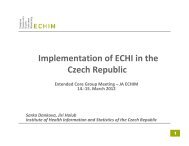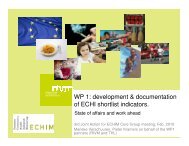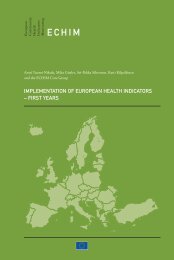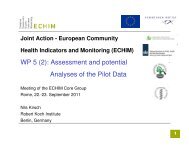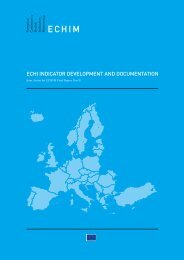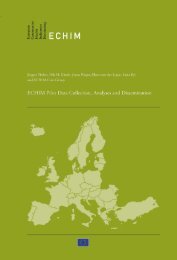INDICATORS
ECHIM Final Report
ECHIM Final Report
Create successful ePaper yourself
Turn your PDF publications into a flip-book with our unique Google optimized e-Paper software.
2.3. Major international data sources<br />
The most relevant international data sources are Eurostat database, OECD Health Data<br />
and the WHO Health for All database.<br />
Eurostat database (www.epp.eurostat.ec.europa.eu/): As for all Eurostat activities,<br />
work is carried out within the European Statistical System. In the area of public health<br />
statistics, main partners in the Member States and associated countries are the National<br />
Statistical Offices, Ministries of Health and Public Health Institutes as the providers<br />
of official statistics on public health. Annual planning and strategic decisions are made<br />
with the Member States at the yearly meeting of the Working Group on Public Health<br />
Statistics. Eurostat’s work in the area of Public Health statistics is structured according<br />
to four main topics:<br />
• Causes of Death statistics<br />
• Health Care statistics<br />
• Health Interview Surveys<br />
• Diagnosis-specific morbidity statistics<br />
The current state of the different areas is briefly summarised below.<br />
1. Causes of Death statistics – COD: Eurostat disseminates COD statistics according<br />
to a shortlist of 65 causes (“Causes of death – European shortlist”, based on the ICD –<br />
International Statistical Classification of Diseases and Related Health Problems, WHO).<br />
Data are available at national and regional level (NUTS 2) for total number, crude death<br />
rates (CDRs) and standardised death rates (SDRs), broken down by age groups and<br />
by sex. While dissemination is according to the European shortlist of 65 causes, more<br />
detailed data (ICD-10 3-digit level) are available for most countries on request.<br />
2. Health Care statistics – CARE (expenditure and non-expenditure data): Eurostat<br />
recently started collecting data on health care expenditure, based on the System of<br />
Health Accounts (SHA). In 2005 a Joint Questionnaire was created in co-operation<br />
with the OECD and WHO Headquarters, using the International Classification for<br />
Health Accounts (ICHA) as presented in the SHA Manual, supplemented with some<br />
classifications developed in the Guide to Producing National Health Accounts by the<br />
WHO. The Joint Questionnaire has reduced the burden of enquiry of the data producers,<br />
because data are only supplied once to all the international organisations of which the<br />
country is a member. A common effort of Eurostat, the OECD and the WHO in this<br />
area will serve additionally as a platform for harmonising institutional approaches and<br />
enhancing further SHA development. The aim of this joint data collection is to supply<br />
a consistent and comparable picture of health care system expenditure of countries,<br />
24




